What is hair porosity?
Hair porosity usually describe the ability of your hair to absorb and maintain moisture. What does hair porosity mean could be comprehended from the structure of the hair.
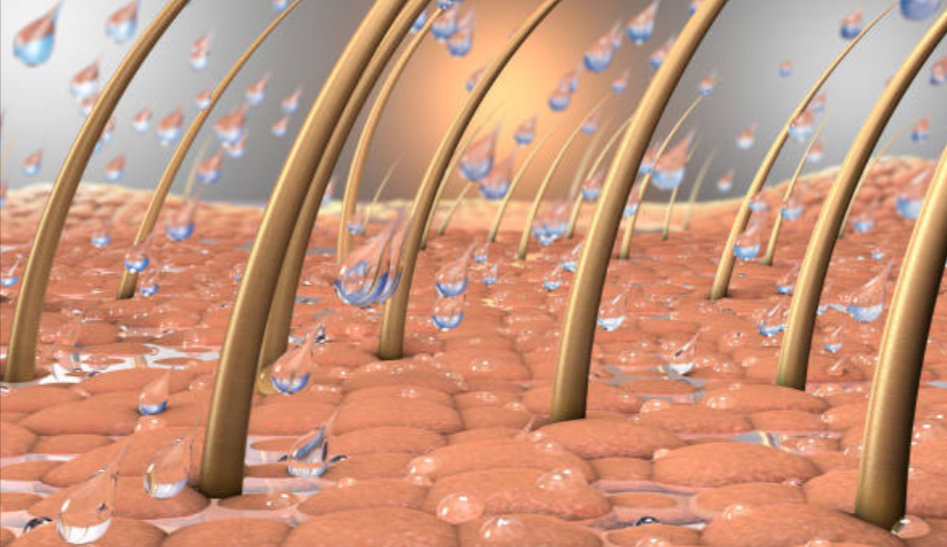
To make the definition of hair porosity clear, you should know that the hair consists of three layers— The cuticle, the cortex, and the medulla.
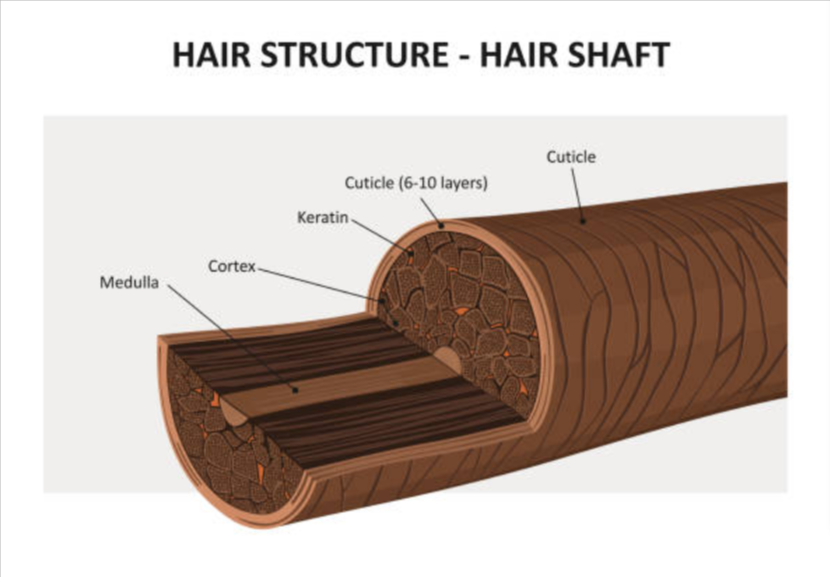
The cuticle in outer layer of the hair strand consists of smaller overlapping cuticles which plays the role of protector.
The cortex contains fibrous proteins and bear the responsibility of providing the pigment to coloring your hair as the thickest layer in hair structure.
The medulla lies in the central of your hair strand.
The outermost layer is composed of tiny cuticles which can not be observed by your naked eyes and it is the distance between cuticles that decides how much moisture, products or chemicals be absorbed so as to safeguard the inner layers of your hair.
When the cuticles get close together in a large scale, they prevent moisture from being absorbed which forms the texture known as low porosity.
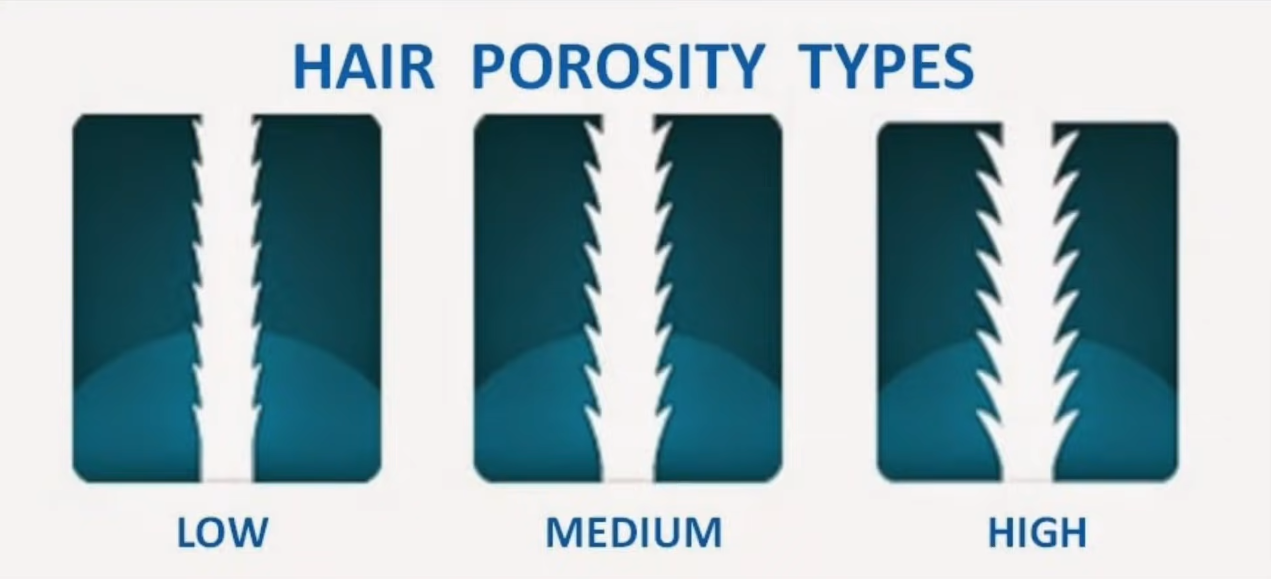
Then it comes high porosity hair. If the cuticles get far way from each other, the situation is quite the opposite—Moisture can be easily absorbed into the hair and easily volatilized which leave little time to nourish and moisturize your hair.
According to how well your hair can keep moisture, it can be classified as three types: low porosity, normal porosity and high porosity.
Why hair porosity is important?
So why do I need to know about hair porosity?

Hair porosity is always a pretty big deal in this curly hair community. Identifying your porosity type is important to keep your hair healthy and growing.
Knowing hair porosity will help you purchasing products fitting your hair best. There is no one product working for everybody, so that even if you do a lot of research on consumers’ reviews and product ingredients, it’s still possible for you to choose wrong products without knowing your hair porosity.
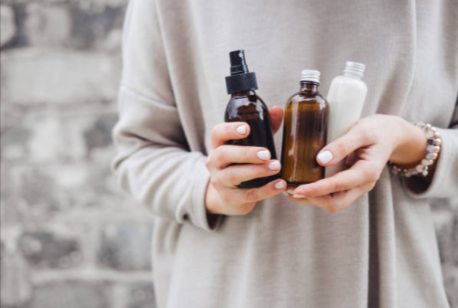
Knowing about hair porosity will save you time in choosing products. You can tell what kinds of products will work well with your hair and abandon some products which spend amount of money every purchase but gain poor effect.
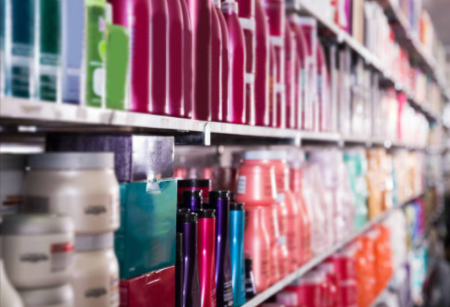
Knowing hair porosity will optimize your hair styling choice. You can identify that how your hair will perform with particular products and whether gel, oil or cream come into effect to your hair and how to reserve your curls hydrated and healthy. In the process of hair growth, hair extensions are of great help to natural hair as a protective way.
If you want to know what kind of hair products are gonna work for your hair, you're gonna have to understand your hair porosity or it's gonna be frizzy.
Let's figure out what type of hair porosity you have.
What are the characteristics of different hair porosity?
Normal porosity hair has cuticles that are neither too loose nor too tight and it can obtain ideal appearance as you want when it’s styling, colouring, and chemical processed.
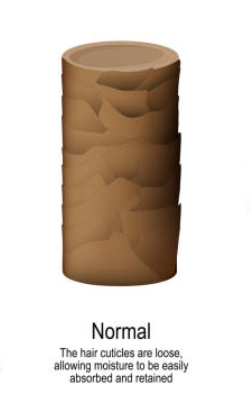
Here are some characteristics of normal porosity hair.
- When you hair get in touch with some water, the water beads will be absorbed by your hair quickly and your hair get becomes wet in short time.
- It’s easy for you to color and style your hair and it doesn’t take long time to manage your hair every time.
- The hair will dry out in normal speed.
Normal porosity presents that your hair is just working out fine. You don't really notice any problems with it, and it's just kind of doing its thing. However, beyond is as wrong as falling short. Frequent chemical treatments will turn normal hair into high porosity hair gradually and it will be difficult over time to last the hairdos.
High porosity and low porosity are where the problems lie.
If you have low porosity hair that means that your hair strands look like this—
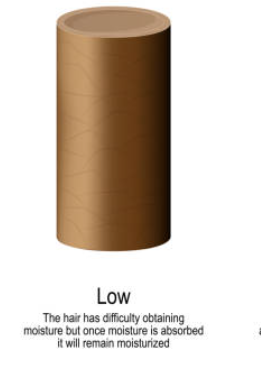
All the cuticles are extremely sealed and closed shut, so it's really hard to allow moisture to come in.
Here are some signs to let you know if you have low porosity here.
—Products are not really absorbed into your hair. They kind of just feel like they sit on your hair and you often get a lot of product build-up.
—Your hair does not absorb hair color very without a hitch. It takes a long time to actually change the color of your hair or to do any style of treatment.
—You might notice water beads on your hair when you get your hair wet You can actually see the water droplets just sitting on your hair and it takes a very long time for your hair to get completely wet when you're in the shower.
—If you use a lot of products that are like Butters and it's just too thick and leaves your hair oily. It might be too much for your hair because of its low porosity.
—Another sign is that your hair takes hours to dry out.
—You might also notice that your hair tangles extremely easy because all the cuticles are getting caught onto each other.
If you have high porosity hair that means your hair strands look like this—
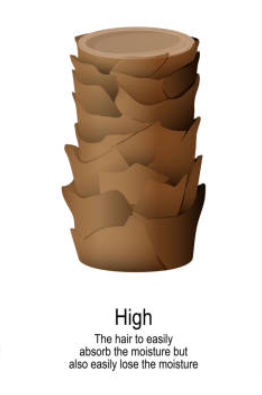
The cuticle is way more open with more widely spaced cuticles so it now can absorb moisture really easily, but it does not retain the moisture easy in and easy out.
—If you have high priority here then you will find that your hair dries extremely fast. when you put in the moisture and next thing you know is that it's sucked all up.
—If you notice that your hair continuously always tends to get frizzy, then it could be brought by high porosity.
—If you use products like lotions and milk and it seem like they just don't work on your hair as a result from that they are not enough for your high porosity hair.
High porosity hair is also referred to hair damaged by UV exposure, heat styling and chemical processing or highly processed because now the cuticles are damaged has difficulty retaining its moisture so they are torn making them more open. to protect these hair damage, it is recommended to put on human wigs or high quality clip in hair extensions made from Brazilian human virgin hair to keep natural hair way from harmful factors.
How to test what hair porosity you have?
Low porosity hair is also known as protein sensitive hair while high porosity hair actually likes the protein very much. So if you can use products with protein or do a DIY wash using eggs, your hair will love it.
Now with that being said, it still kind of tricky on trying to figure out kind of process you have. Because you might be thinking as it is—my hair does take a long time to dry, but it is often dry and frizzy. So what kind of hair porosity do I have?
Well, there are a couple tests you can do to tell the hair types.
The first test that you might have heard about is the cup test.
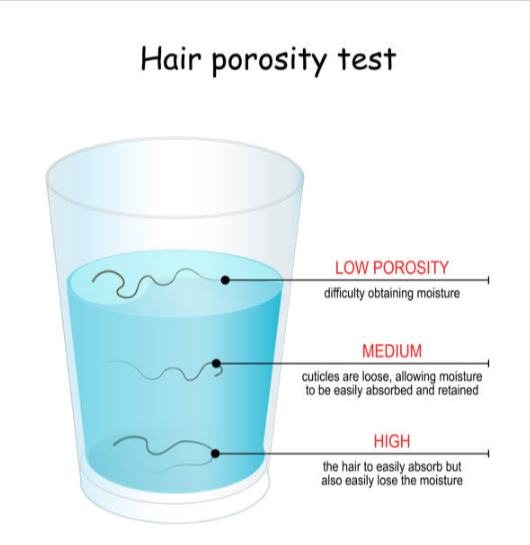
The cup test requires you to prepare for a glass of water. Take a strand of your hair and just place it in the water. If your hair is floating, it means that you have low porosity hair and the cuticles are sealed. It's not allowing any moisture in, so it's not sinking to the bottom,
If the hair strand is kind of just staying in the middle and floating just where it's supposed to be, it turns out to be normal hair.
And if your hair has sunk all the way down to the bottom of the cup, it means that your hair took in the moisture. That’s high porosity hair which was able to absorb the moisture and sink really easy.
The second porosity test you could try is the spray test.

You can get a water bottle with a spray and spray your hair.
If you notice that there are beads of water just sitting on your hair then you can come to the conclusion that you have low porosity hair because it's not allowing the moisture in and it's really hard to moisturize your curls if you spray your hair.

If the water was instantly absorbed, it means that your cuticles are open and just ready to take in the moisture. You might have high porosity hair.
The last test you could do is the strand test.

Take one strand of your hair and then move your fingers up and down.
If it feels like smooth and straight then you might have low porosity hair. If you feel like a little bit ridges or bumps then that means your cuticles are open and you have high porosity hair.
How to care for normal porosity hair?
Normal porosity hair, which have not too much and not too little moisture going inside of the here because the cuticles are not opened up and are not too close together, then you find that persons with medium hair porosity retains sufficient moisture and does not lose moisture at that much.
Form a clarifying routine to avoid your hair lose it’s balance.
Do regular moisturizing and sealing probably one to three times a week with your creams, butters or lighter moisturizers based on the type of your hair.
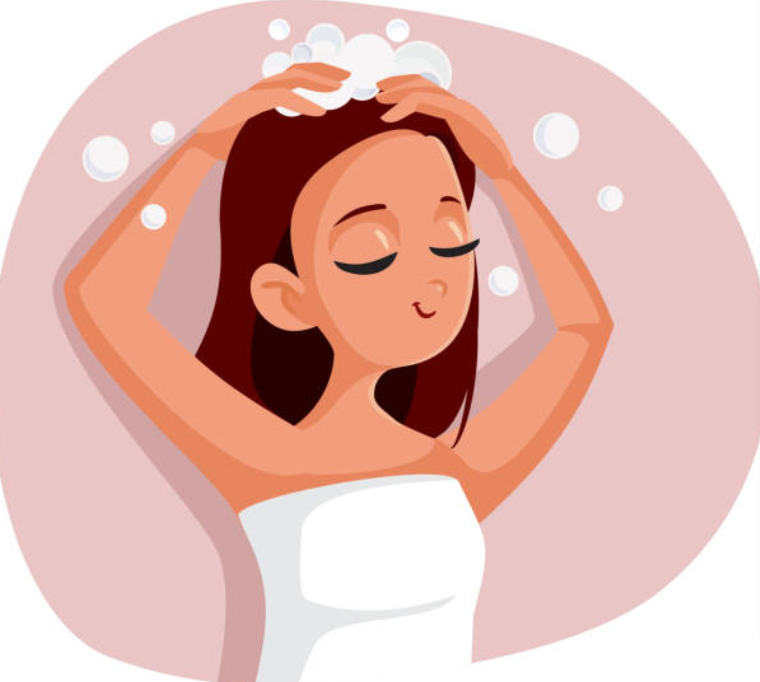
Wash or style your hair with warm water. Cold water is going to close your cuticles if you're using cold water to style your hair. warm water will open your cuticles so that the moisture from your products are able to be absorbed more easily and better.
Applying your products on damp hair tend to get the best results. Dry hair will be more frizzy.
Deep condition with heat. Wash your hair while in the shower. Use a steamer or a hooded dryer with the heating cap and you can do what you need to do without any cares.

Use multiple lightweight products while you're styling and layer your product. You don't need that many things on your hair and that will also create build up on your hair.
Use protein treatments every once in a while to keep protein moisture balance. Protein is what your hair is made up of and if you're always putting moisturizers in your hair and you're always using deep conditioners that are moisturizing then never using protein treatments. If you're using a protein treatment twice a month or once a month, that's a good way to start off.
How to care for high porosity hair?
High porosity hair with seams in the cuticle layer allows moisture to enter quickly in and out which may cause your hair frizz and tangling when the weather is humid and dry in fine weather.

How to wash high porosity hair?
If you have high porosity hair, rinse your hair with cold water. Put moisturizing conditioner in your hair and stay in. That's because if you close the cuticles and seal them with cold water, it will last a lot longer.
What products to use for high porosity hair?
Products like butters, cream and oils like coconut oil, jojoba oil and aloe Vera gel are beneficial to high porosity hair with a lot of nourishment and moisture. It is also better for high processing hair to just air dry. You don't need any extra help with the drying because it dries super fast and opposite of low process.
How to care for low porosity hair?
Low porosity hair has tight cuticles and it’s essential to choose lightweight products that can penetrate your hair through the tight cuticles and sink deeper into the hair. If you have low porosity hair, here are some tips to take care of low porosity hair.
First of all, when it comes to deep conditioning your hair, you can use some heat to open up the cuticles. This is why you can find that there are a lot of deep conditioning products which appear to be applied with a heat cap or to be put under a dryer for a a while.
This method will open up the shafts of your low porosity hair. And you could also heat up your deep conditioning treatments before you put them on your hair. Many people with low porosity hair will prepare a hooded dryer at home as well.
How to wash low porosity hair?
If you don’t want to use heating tools on your hair, another way to achieve the same effect like a blow dryer is to wash your hair with hot water. Wash your low porosity hair with normal warm water as same as that you use when wash your body.

Do not rinse your hair with cold water. rinse your hair with cold water has no different with closing out your hair cuticles and it is exactly the problem that low prosperity hair has. You want to be able to open up the hair cuticles so it can actually start to retain the moisture.
But all you’ve done is just sealing it off in your hair. It isn't gonna be able to retain any kind of moisture when you put in your product or whatever you do and it's just sit on top of your hair even more.
How often should wash low porosity hair?
The simple answer is that you should moisturize low porosity hair whenever it feels dry. It’s common for most low porosity hair people to work for extra-dry hair a couple of times a week. For someone else, once a week should do the trick. If your hair feels dry every day and you’re wondering how to moisturize low porosity hair daily, you can hydrate your hair with water and a leave-in conditioner.
What products to use for low porosity hair?
Keep in mind that it's very important when buying hair products for low porosity hair—choose lighter products for low porosity hair.
Water-based hair products are conducive to smooth your edges, reduce frizz without leaving product build-up.
Get a good clarifying shampoo and products that your hair likes such as argan oil. almond oil and grapeseed oil. Because low porosity hair does tend to get a lot of product build up and it is good to use an apple cider vinegar to rinse every so often to really cleanse the scalp.
Avoid products with protein. Protein can strengthen the hair cuticle by fixing the cuticles but low porosity hair is sensitive to protein and will be stiff and fragile with extra protein.



